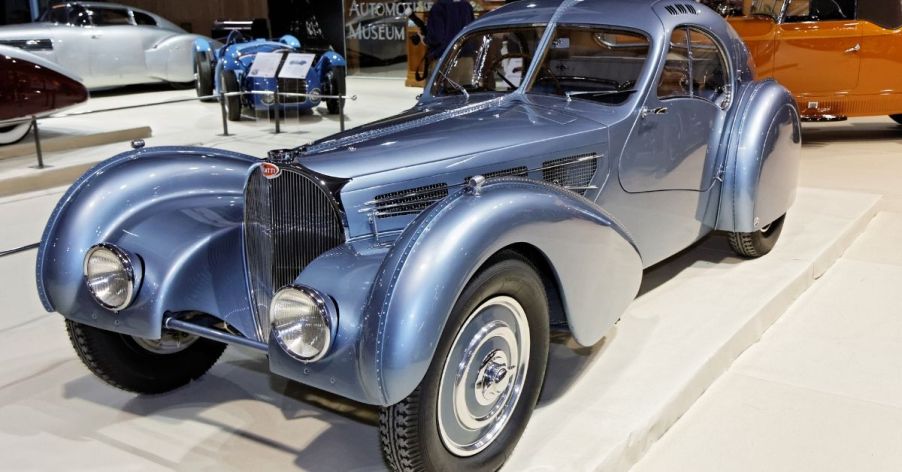
15 Unforgettable French Cars

In the auto industry, French cars are celebrated for their combination of style, innovation, and engineering prowess. They prioritize comfort and driving pleasure and have pioneered technologies and eco-friendly advancements. If you’re a car enthusiast or just curious about automotive history, read on to discover 15 incredible French cars that are simply unforgettable.
Bugatti Type 57SC Atlantic (1934–1940)

Many enthusiasts consider Bugatti’s Type 57SC Atlantic one of the most beautiful and rarest cars ever made—only four units were built. Featuring a sleek, aerodynamic design, the classic, according to Auto Evolution, had a supercharged 3.3L inline-eight engine and a top speed of 123 mph.
Citroën 2CV (1948–1990)

Affectionately known as the Deux Chevaux (Two Horses), the Citroën 2CV was initially developed to mobilize rural France. The car was affordable, fuel-efficient, and capable of traversing rough roads. Retro Motor reports that the car’s modest two-cylinder engine allowed the car to cover long distances at a leisurely pace.
Citroën DS (1955–1975)

The Citroën DS revolutionized automotive design when it debuted in 1955. Its futuristic design, created by sculptor Flaminio Bertoni, featured aerodynamic bodywork that stood apart from the boxy cars of the era. However, according to Fresques.ina, the DS introduced several innovative technologies, including the hydropneumatic self-leveling suspension.
Renault 4 (1961–1994)

The Renault 4 was one of the most versatile French cars of the 20th century. It was initially designed to compete with the Citroën 2CV, offering a more spacious and comfortable alternative. Noted for its simple, rugged design, the Renault 4 was a “people’s car,” affordable and accessible to everyone.
Alpine A110 (1961–1977; 2017–Present)

First introduced in 1961, the A110 was built by French manufacturer Alpine and won the inaugural World Rally Championship. Ultimate Car Page states that early versions featured a rear-engine, rear-wheel-drive layout, and a fiberglass body. Alpine resurrected the A110 in 2017, combining the original design with the latest automotive technology.
Peugeot 504 (1968–1983)

Recognized for its durability, comfort, and timeless design, the Peugeot 504 was first introduced in 1968. Its sturdy construction made it a favorite in Europe, Africa, and South America. Additionally, the 504 was a successful rally car, performing exploits in endurance events like the East African Safari Rally.
Citroën SM (1970–1975)

This grand tourer combined advanced technology with stunning design. Built in collaboration with Maserati, it had a Maserati V6 engine, which gave the SM impressive performance for its time. Furthermore, information by Auto Evolution credits the Citroën for featuring hydropneumatic suspension and an advanced steering system that adjusted assistance level with speed.
Citroën CX (1974–1991)

Citroën launched the CX in 1974 to replace the DS as Citroën’s flagship model. The CX offered advanced features, like self-centering steering, advanced suspension, and aerodynamic styling. Designed to be as comfortable as possible, it featured a hydropneumatic suspension system that provided an extraordinarily smooth ride.
Renault 5 Turbo (1980–1986)

Released in 1980, Renault’s 5 Turbo was a rally-bred hot hatch. With its mid-mounted turbocharged engine, flared wheel arches, and aggressive stance, it was designed for the road and track. According to Auto Evolution, the car’s 158-horsepower 1.4L turbocharged engine propelled it to 60 mph in under seven seconds.
Peugeot 205 GTi (1984–1994)

Peugeot’s 205 GTi is one of the best hot hatches of the 1980s. Lightweight and powered by a 1.6L or 1.9L engine, it had an impressive power-to-weight ratio. Beyond its technical merits, the GTi won numerous rally championships, including the World Rally Championship (WRC) Group B.
Renault Clio (1990–Present)

Since its debut in 1990, the Renault Clio has been celebrated for its versatility, performance, and reliability. The successor to the Renault 5, it has twice won the European Car of the Year award. Sporty variants, like the Clio RS, offer exceptional output, attracting enthusiasts seeking affordable performance cars.
Venturi 400 GT (1994–1996)

According to Auto Data, Venturi, a small French car manufacturer, built only a handful of the 400 GT, making it one of the most exclusive cars of its time. Powered by a 400-horsepower twin-turbocharged 3.0L V6 engine, the 400 GT could sprint to 60 mph in just 4.7 seconds.
Bugatti Veyron (2005–2015)

When Bugatti re-entered the supercar market under the Volkswagen Group’s ownership, the Veyron was its crowning achievement. With a colossal 8.0L quad-turbocharged W16 engine, the Veyron became the first production car to surpass the 1,000-horsepower mark. Auto Evolution also reports that the vehicle could reach over 250 mph.
Peugeot 3008 (2009–Present)

Released in 2009, the Peugeot 3008 was a game-changer for Peugeot. As a compact crossover SUV, it combines the many advantages of an SUV with the impressive agility of a compact car. The second-generation 3008, introduced in 2016, had sharp lines and a futuristic interior that significantly shifted from Peugeot’s design language.
DS 3 Crossback (2018–Present)

The DS 3 Crossback is a luxury subcompact SUV from the premium French brand DS Automobiles. It stands out with its avant-garde design, featuring a bold grille, sleek LED lights, and striking exterior and interior details. Its powertrains include all-electric versions that appeal to eco-conscious drivers.


